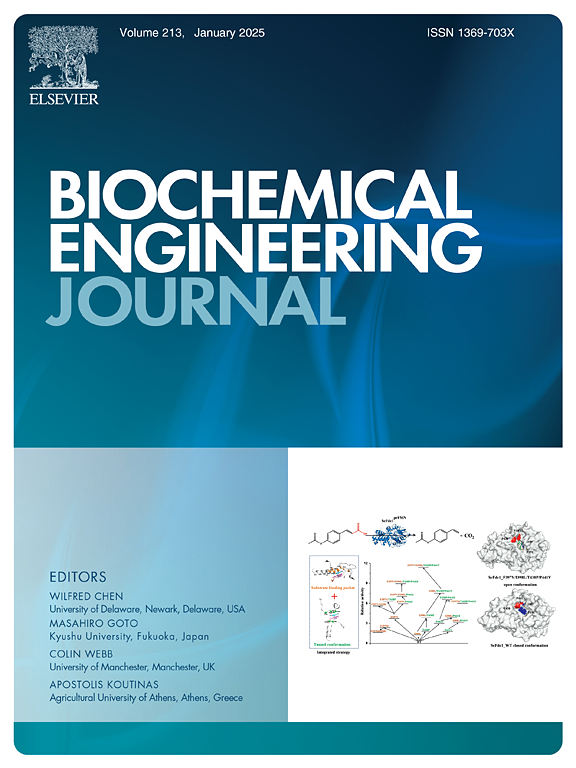Xylonic acid: A novel approach to bioproduction by sustainable strategies
IF 3.7
3区 生物学
Q2 BIOTECHNOLOGY & APPLIED MICROBIOLOGY
引用次数: 0
Abstract
Despite its recognized potential use in polyamides, cosmetic formulations, hydrogels, and as an antimicrobial, the sustainable bioproduction of xylonic acid remains underestimated in the field of industrial biotechnology. In parallel, sorbitol, a high added-value polyol widely used in the food and pharmaceutical industries, can also be obtained through biotechnological routes. Both compounds can be synthesized from xylose and fructose through the coordinated enzymatic action of glucose-fructose oxidoreductase (GFOR) and glucono-δ-lactonase (GL), periplasmic enzymes produced by Zymomonas mobilis cells. In this study, the activity of the GFOR/GL complex was evaluated under different pH (5.8–7.6) and temperature (34–53 °C) conditions, using 700 mmol/L of xylose/fructose as substrates and 4 g/L of biocatalyst. The optimum activity conditions were identified between pH 6.8–7.2 and 47–50 °C. Subsequent bioconversion trials demonstrated impressive xylonic acid yields of 90 % at 39 °C and pH 6.4 using free enzymes, and 89 % at 43 °C and pH 6.4 when enzymes were immobilized in calcium alginate. Reusability tests revealed the immobilized biocatalyst's stable performance over five cycles, exhibiting no significant loss of efficiency in xylonic acid production. These findings underscore the potential of the GFOR/GL system as an efficient and sustainable alternative for valorizing renewable sugars into high-value industrial products.
木糖酸:一种可持续发展的生物生产新方法
尽管它在聚酰胺、化妆品配方、水凝胶和抗菌剂中具有公认的潜在用途,但在工业生物技术领域,二甲苯酸的可持续生物生产仍然被低估。同时,山梨糖醇是一种高附加值的多元醇,广泛应用于食品和制药工业,也可以通过生物技术途径获得。这两种化合物都可以由木糖和果糖合成,通过葡萄糖-果糖氧化还原酶(GFOR)和葡萄糖-δ-内酯酶(GL)的协同酶促作用,葡萄糖-果糖氧化还原酶(GFOR)和葡萄糖-δ-内酯酶(GL)是由活动单胞菌细胞产生的质周酶。本研究以700 mmol/L木糖/果糖和4 g/L生物催化剂为底物,在不同pH(5.8-7.6)和温度(34-53℃)条件下,对GFOR/GL复合物的活性进行了评价。在pH 6.8 ~ 7.2和47 ~ 50℃范围内确定了最佳的活性条件。随后的生物转化试验表明,使用游离酶在39°C和pH 6.4条件下,木糖酸的产率为90% %,而在43°C和pH 6.4条件下,将酶固定在海藻酸钙中,木糖酸的产率为89% %。重复使用测试表明,固定化生物催化剂在5个循环中性能稳定,在生产二甲苯酸方面没有明显的效率损失。这些发现强调了GFOR/GL系统作为将可再生糖转化为高价值工业产品的有效和可持续替代方案的潜力。
本文章由计算机程序翻译,如有差异,请以英文原文为准。
求助全文
约1分钟内获得全文
求助全文
来源期刊

Biochemical Engineering Journal
工程技术-工程:化工
CiteScore
7.10
自引率
5.10%
发文量
380
审稿时长
34 days
期刊介绍:
The Biochemical Engineering Journal aims to promote progress in the crucial chemical engineering aspects of the development of biological processes associated with everything from raw materials preparation to product recovery relevant to industries as diverse as medical/healthcare, industrial biotechnology, and environmental biotechnology.
The Journal welcomes full length original research papers, short communications, and review papers* in the following research fields:
Biocatalysis (enzyme or microbial) and biotransformations, including immobilized biocatalyst preparation and kinetics
Biosensors and Biodevices including biofabrication and novel fuel cell development
Bioseparations including scale-up and protein refolding/renaturation
Environmental Bioengineering including bioconversion, bioremediation, and microbial fuel cells
Bioreactor Systems including characterization, optimization and scale-up
Bioresources and Biorefinery Engineering including biomass conversion, biofuels, bioenergy, and optimization
Industrial Biotechnology including specialty chemicals, platform chemicals and neutraceuticals
Biomaterials and Tissue Engineering including bioartificial organs, cell encapsulation, and controlled release
Cell Culture Engineering (plant, animal or insect cells) including viral vectors, monoclonal antibodies, recombinant proteins, vaccines, and secondary metabolites
Cell Therapies and Stem Cells including pluripotent, mesenchymal and hematopoietic stem cells; immunotherapies; tissue-specific differentiation; and cryopreservation
Metabolic Engineering, Systems and Synthetic Biology including OMICS, bioinformatics, in silico biology, and metabolic flux analysis
Protein Engineering including enzyme engineering and directed evolution.
 求助内容:
求助内容: 应助结果提醒方式:
应助结果提醒方式:


